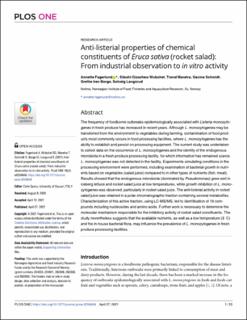| dc.contributor.author | Fagerlund, Annette | |
| dc.contributor.author | Wubshet, Sileshi Gizachew | |
| dc.contributor.author | Møretrø, Trond | |
| dc.contributor.author | Schmidt, Gesine | |
| dc.contributor.author | Borge, Grethe Iren Andersen | |
| dc.contributor.author | Langsrud, Solveig | |
| dc.date.accessioned | 2021-04-30T07:21:59Z | |
| dc.date.available | 2021-04-30T07:21:59Z | |
| dc.date.created | 2021-04-29T10:22:57Z | |
| dc.date.issued | 2021 | |
| dc.identifier.citation | PLOS ONE. 2021, 16 (4), . | |
| dc.identifier.issn | 1932-6203 | |
| dc.identifier.uri | https://hdl.handle.net/11250/2740464 | |
| dc.description.abstract | he frequency of foodborne outbreaks epidemiologically associated with Listeria monocytogenes in fresh produce has increased in recent years. Although L. monocytogenes may be transferred from the environment to vegetables during farming, contamination of food products most commonly occurs in food processing facilities, where L. monocytogenes has the ability to establish and persist on processing equipment. The current study was undertaken to collect data on the occurrence of L. monocytogenes and the identity of the endogenous microbiota in a fresh produce processing facility, for which information has remained scarce. L. monocytogenes was not detected in the facility. Experiments simulating conditions in the processing environment were performed, including examination of bacterial growth in nutrients based on vegetables (salad juice) compared to in other types of nutrients (fish, meat). Results showed that the endogenous microbiota (dominated by Pseudomonas) grew well in iceberg lettuce and rocket salad juice at low temperatures, while growth inhibition of L. monocytogenes was observed, particularly in rocket salad juice. The anti-listerial activity in rocket salad juice was retained in a polar chromatographic fraction containing several metabolites. Characterization of this active fraction, using LC-MS/MS, led to identification of 19 compounds including nucleosides and amino acids. Further work is necessary to determine the molecular mechanism responsible for the inhibitory activity of rocket salad constituents. The study nevertheless suggests that the available nutrients, as well as a low temperature (3 ˚C) and the in-house bacterial flora, may influence the prevalence of L. monocytogenes in fresh produce processing facilities. | |
| dc.language.iso | eng | |
| dc.title | Anti-listerial properties of chemical constituents of Eruca sativa (rocket salad): From industrial observation to in vitro activity | |
| dc.type | Peer reviewed | |
| dc.type | Journal article | |
| dc.description.version | publishedVersion | |
| dc.source.pagenumber | 22 | |
| dc.source.volume | 16 | |
| dc.source.journal | PLOS ONE | |
| dc.source.issue | 4 | |
| dc.identifier.doi | 10.1371/journal. pone.0250648 | |
| dc.identifier.cristin | 1907156 | |
| dc.relation.project | Norges forskningsråd: 234355 | |
| dc.relation.project | Norges forskningsråd: 224921 | |
| dc.relation.project | Nofima AS: 201305 | |
| dc.relation.project | Norges forskningsråd: 262306 | |
| dc.relation.project | Norges forskningsråd: 262308 | |
| dc.relation.project | Norges forskningsråd: 262300 | |
| dc.relation.project | Nofima AS: 201701 | |
| dc.relation.project | Nofima AS: 201704 | |
| dc.relation.project | Nofima AS: 201702 | |
| dc.relation.project | Nofima AS: 10805 | |
| cristin.ispublished | true | |
| cristin.fulltext | original | |
| cristin.qualitycode | 1 | |
